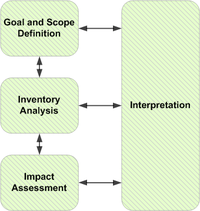
Photo from wikipedia
Bio-derived fibres and resins are of increasing interest as alternatives to petrochemicals in the production of so-called environmentally friendly composite materials. However, whilst the majority of systems consider complete replacement,… Click to show full abstract
Bio-derived fibres and resins are of increasing interest as alternatives to petrochemicals in the production of so-called environmentally friendly composite materials. However, whilst the majority of systems consider complete replacement, another route is to look at the constituents that are required to give certain properties, including the content of diluents; a third is to identify ‘hot spots’ in manufacturing. This paper considers these three possibilities in the context of the production of a resin system, and presents results from a life cycle assessment. The aim of this study was to make qualitative assertions based on quantitative estimates. The current work provides a practical assessment of the contribution of the manufacturing process of a multi-part resin formulation to a range of environmental impacts. As a part of this, a multi-stage methodology, the first of its kind, which is more relevant for the batch processes used to manufacture many structural thermosetting polymer systems, was developed. This was applied to a range of resins, some of which include bio-mass derived precursors. For the boundary conditions used, the indications are that the impacts due to taking the constituents and processing them to produce the resin system are insignificant compared with those due to producing the feedstocks in the first place. Surprisingly, whether the feedstocks were from fossil resources or were bioderived was of little significance. As a consequence of the analysis, it has been demonstrated that whilst a manufacturer can make significant savings through careful management of plant and the supporting energy mix, significant improvements to the environmental impacts of resin systems can be made through the choice of particular monomers.
Journal Title: Sustainability
Year Published: 2019
Link to full text (if available)
Share on Social Media: Sign Up to like & get
recommendations!